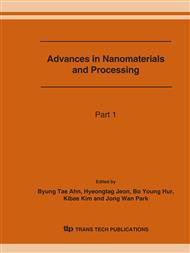p.551
p.555
p.559
p.563
p.567
p.571
p.575
p.579
p.583
Formation and Optical Properties of ZnSe Self-Assembled Quantum Dots in Cl-Doped ZnSe Thin Films Grown on GaAs (100) Substrates
Abstract:
The high-resolution scanning electron microscopy (HRSEM) image showed that selfassembled ZnSe small quantum dots (QDs) and large nanodots with a pyramid shape were formed in the Cl-doped ZnSe epilayers grown on GaAs (100) substrates. The formation of the ZnSe QDs was attributed to three-dimensional growth controlled by distribution of the impurities in the Cldoped ZnSe epilayrs. Cathodoluminescence (CL) measurements at room temperature revealed the emission peak at 3.1 eV corresponding to the blue shift approximately 400 meV from the near band edge emission of 2.7 eV in the bulk ZnSe. The blue shifted CL peak indicates the quantum confinement effect resulting from the formation of the ZnSe QDs in the Cl-doped ZnSe thin film. While the peak position of the donor-acceptor pair emission shifted to higher energies with decreasing temperature, the band-edge emission peak for the QDs did not significantly change.
Info:
Periodical:
Pages:
567-570
Citation:
Online since:
June 2007
Authors:
Keywords:
Price:
Сopyright:
© 2007 Trans Tech Publications Ltd. All Rights Reserved
Share:
Citation:


